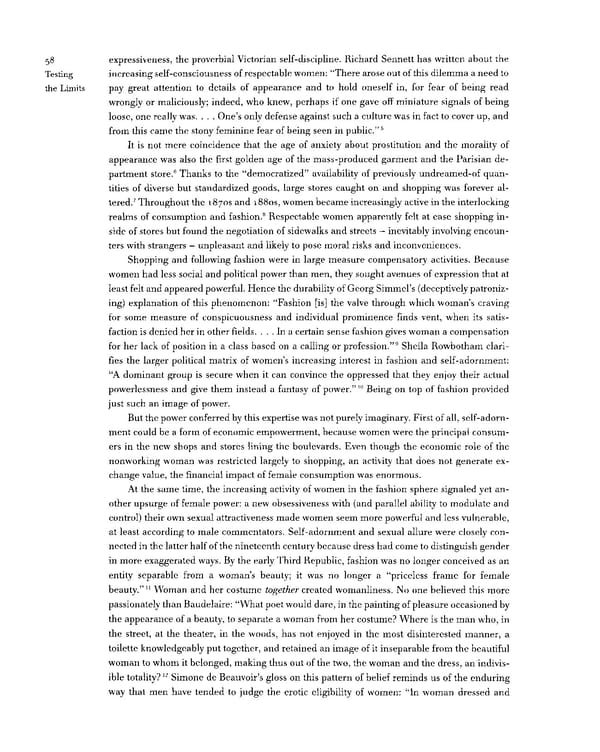58 expressiveness, the proverbial Victorian self-discipline. Richard Sennett has written about the Testing increasing self-consciousness of respectable women: "There arose out of this dilemma a need to the Limits pay great attention to details of appearance and to hold oneself in, for fear of being read wrongly or maliciously; indeed, who knew, perhaps if one gave off miniature signals of being loose, one really was. . . . One's only defense against such a culture was in fact to cover up, and from this came the stony feminine fear of being seen in public."5 It is not mere coincidence that the age of anxiety about prostitution and the morality of appearance was also the first golden age of the mass-produced garment and the Parisian de- partment store.6 Thanks to the "democratized" availability of previously undreamed-of quan- tities of diverse but standardized goods, large stores caught on and shopping was forever al- 7 tered. Throughout the 18708 and i88os, women became increasingly active in the interlocking 8 realms of consumption and fashion. Respectable women apparently felt at ease shopping in- side of stores but found the negotiation of sidewalks and streets — inevitably involving encoun- ters with strangers — unpleasant and likely to pose moral risks and inconveniences. Shopping and following fashion were in large measure compensatory activities. Because women had less social and political power than men, they sought avenues of expression that at least felt and appeared powerful. Hence the durability of Georg Simmers (deceptively patroniz- ing) explanation of this phenomenon: "Fashion [is] the valve through which woman's craving for some measure of conspicuousness and individual prominence finds vent, when its satis- faction is denied her in other fields. ... In a certain sense fashion gives woman a compensation 9 for her lack of position in a class based on a calling or profession." Sheila Rowbotham clari- fies the larger political matrix of women's increasing interest in fashion and self-adornment: "A dominant group is secure when it can convince the oppressed that they enjoy their actual 10 powerlessness and give them instead a fantasy of power." Being on top of fashion provided just such an image of power. But the power conferred by this expertise was not purely imaginary. First of all, self-adorn- ment could be a form of economic empowerment, because women were the principal consum- ers in the new shops and stores lining the boulevards. Even though the economic role of the nonworking woman was restricted largely to shopping, an activity that does not generate ex- change value, the financial impact of female consumption was enormous. At the same time, the increasing activity of women in the fashion sphere signaled yet an- other upsurge of female power: a new obsessiveness with (and parallel ability to modulate and control) their own sexual attractiveness made women seem more powerful and less vulnerable, at least according to male commentators. Self-adornment and sexual allure were closely con- nected in the latter half of the nineteenth century because dress had come to distinguish gender in more exaggerated ways. By the early Third Republic, fashion was no longer conceived as an entity separable from a woman's beauty; it was no longer a "priceless frame for female 11 beauty." Woman and her costume together created womanliness. No one believed this more passionately than Baudelaire: "What poet would dare, in the painting of pleasure occasioned by the appearance of a beauty, to separate a woman from her costume? Where is the man who, in the street, at the theater, in the woods, has not enjoyed in the most disinterested manner, a toilette knowledgeably put together, and retained an image of it inseparable from the beautiful woman to whom it belonged, making thus out of the two, the woman and the dress, an indivis- 12 ible totality? Simone de Beauvoir's gloss on this pattern of belief reminds us of the enduring way that men have tended to judge the erotic eligibility of women: "In woman dressed and
 Prostitution & Impressionists Page 78 Page 80
Prostitution & Impressionists Page 78 Page 80